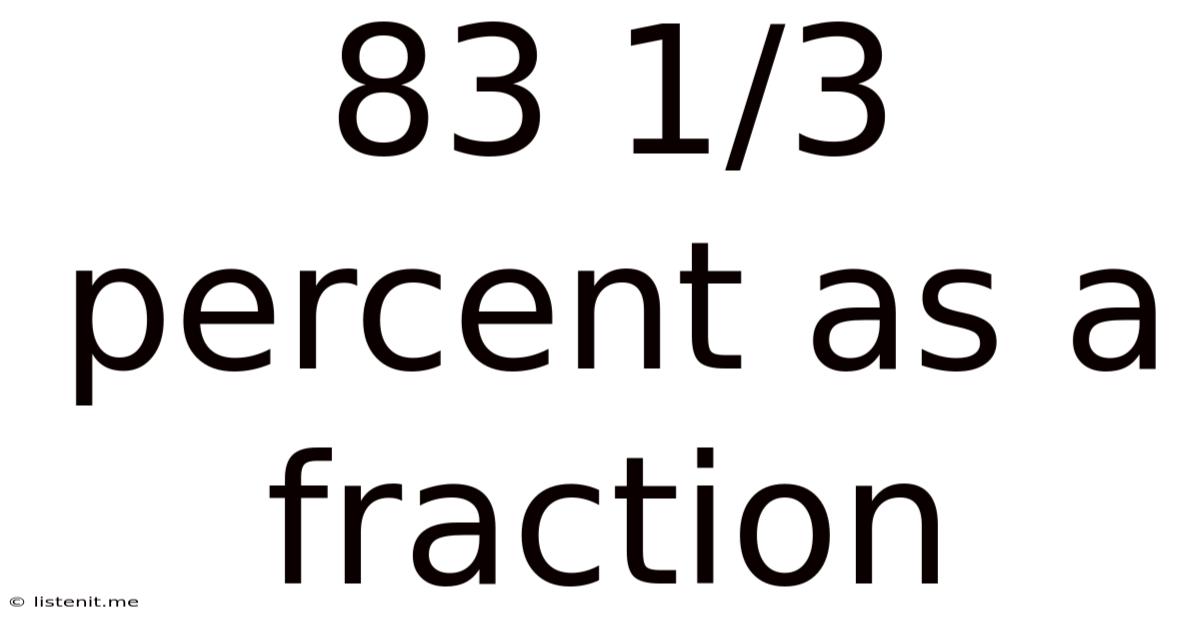83 1/3 Percent As A Fraction
listenit
May 25, 2025 · 4 min read

Table of Contents
83 1/3 Percent as a Fraction: A Comprehensive Guide
Converting percentages to fractions is a fundamental skill in mathematics with applications across various fields, from finance and cooking to construction and data analysis. This article delves deep into the conversion of 83 1/3 percent to its fractional equivalent, exploring the process step-by-step and examining the underlying mathematical principles. We'll also discuss the practical applications of this conversion and explore related concepts.
Understanding Percentages and Fractions
Before diving into the conversion, let's refresh our understanding of percentages and fractions.
Percentage: A percentage represents a fraction of 100. For example, 50% means 50 out of 100, or 50/100. Percentages are widely used to express proportions or ratios.
Fraction: A fraction represents a part of a whole. It's expressed as a numerator (the top number) divided by a denominator (the bottom number). For example, 1/2 represents one part out of two equal parts.
Converting 83 1/3 Percent to a Fraction: A Step-by-Step Guide
The conversion of 83 1/3% to a fraction involves several steps:
Step 1: Convert the mixed percentage to an improper fraction:
The percentage 83 1/3% is a mixed number percentage. First, we need to convert this mixed number into an improper fraction. To do this, we multiply the whole number (83) by the denominator of the fraction (3), add the numerator (1), and keep the same denominator.
83 x 3 + 1 = 250
So, 83 1/3 becomes 250/3.
Step 2: Rewrite the percentage as a fraction:
Now, we rewrite 250/3 as a fraction of 100. Remember that a percentage is always a fraction of 100. Therefore:
83 1/3% = 250/3% = 250/3 / 100
Step 3: Simplify the complex fraction:
We now have a complex fraction (a fraction within a fraction). To simplify, we multiply the numerator by the reciprocal of the denominator (flipping the denominator fraction):
250/3 x 1/100 = 250/300
Step 4: Simplify the fraction:
The fraction 250/300 can be simplified by finding the greatest common divisor (GCD) of both the numerator and the denominator. The GCD of 250 and 300 is 50. We divide both the numerator and the denominator by 50:
250 ÷ 50 = 5 300 ÷ 50 = 6
Therefore, the simplified fraction is 5/6.
Therefore, 83 1/3% is equivalent to the fraction 5/6.
Verifying the Conversion
We can verify this conversion by converting the fraction 5/6 back to a percentage. To do this, we divide the numerator by the denominator and multiply by 100:
(5 ÷ 6) x 100 ≈ 83.333...%
This confirms that our conversion is correct. The slight difference from 83 1/3% is due to the recurring decimal in the percentage representation.
Practical Applications of Converting 83 1/3% to a Fraction
The ability to convert percentages to fractions is invaluable in various real-world situations. Here are some examples:
1. Calculating Discounts and Sales Tax:
Imagine a store offers a discount of 83 1/3% on an item. Knowing that this is equivalent to 5/6 allows for quicker mental calculation. If the original price is $60, the discount would be (5/6) * $60 = $50.
2. Construction and Engineering:
In construction projects, precise measurements are critical. Converting percentages to fractions often leads to more accurate calculations, especially when dealing with complex angles or proportions.
3. Baking and Cooking:
Recipes often include ingredients expressed as fractions. Converting percentages to fractions is necessary for accurate measurements and consistent results.
4. Financial Calculations:
In finance, converting percentages to fractions can simplify calculations involving interest rates, dividends, or profit margins.
5. Data Analysis and Statistics:
In statistical analysis, converting percentages to fractions helps in simplifying the representation of data proportions and conducting further calculations efficiently.
Related Concepts and Further Exploration
Understanding the conversion of 83 1/3% to 5/6 opens doors to exploring related mathematical concepts:
-
Equivalent Fractions: Many fractions can represent the same value. For example, 1/2, 2/4, and 3/6 are all equivalent fractions.
-
Simplifying Fractions: Reducing fractions to their simplest form involves finding the greatest common divisor (GCD) of the numerator and denominator.
-
Improper Fractions and Mixed Numbers: Understanding the relationship between improper fractions (where the numerator is greater than the denominator) and mixed numbers (a combination of a whole number and a fraction) is crucial for various calculations.
-
Decimal Representation: Fractions can also be expressed as decimals by dividing the numerator by the denominator.
-
Ratio and Proportion: Percentages, fractions, and decimals are all different ways of expressing ratios and proportions.
Conclusion
Converting 83 1/3% to the fraction 5/6 is a straightforward process involving several steps. Understanding this conversion and related concepts is crucial for numerous applications across various fields. By mastering the conversion of percentages to fractions, you enhance your mathematical skills and ability to tackle real-world problems with greater accuracy and efficiency. The practical examples highlighted throughout this article demonstrate the broad applicability of this fundamental mathematical skill. Further exploration into the topics mentioned above will solidify your understanding and unlock more complex mathematical applications.
Latest Posts
Latest Posts
-
How To Calculate Semi Monthly Pay Hourly
May 25, 2025
-
600 Is How Many Times As Much As 20
May 25, 2025
-
What Is The Least Common Multiple Of 15 And 8
May 25, 2025
-
How Many Days Has It Been Since May 12
May 25, 2025
-
What Year Were You Born If You Are 28
May 25, 2025
Related Post
Thank you for visiting our website which covers about 83 1/3 Percent As A Fraction . We hope the information provided has been useful to you. Feel free to contact us if you have any questions or need further assistance. See you next time and don't miss to bookmark.